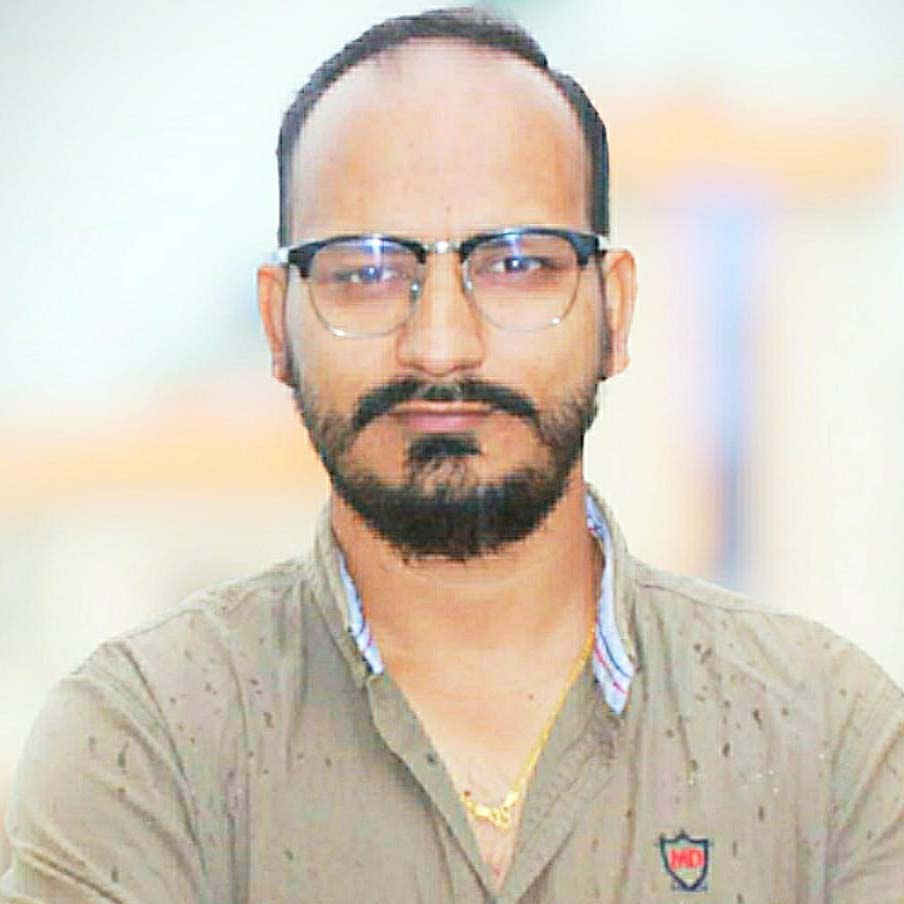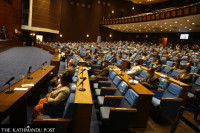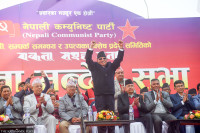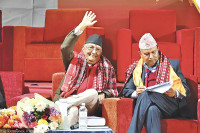Politics
When will women lead big political parties?
Bibeksheel Sajha recently elected Samikchya Baskota as party chief while Ranjita Shrestha heads another new party, the Nagarik Unmukti Party.
Purushottam Poudel
While women leaders in traditional political parties are confined to powerless positions, new parties like the Bibeksheel Sajha and the Nagarik Unmukti are showing the way to the major forces.
Bibeksheel Sajha has elected Samikchya Baskota as party chief whereas another female leader Ranju Darshana was elected as the general secretary of the party at its general convention on February 11. Although a few women leaders have led their respective parties in the past, Bibeksheel Sajha’s case is different, as the emergent party has elected two women leaders in its two most powerful positions from the general convention.
Though not elected, Ranjita Shrestha is another woman leader who heads a party. Nagarik Unmukti under the leadership of Shrestha won three first-past-the-post (FPTP) seats in the House of Representatives in the November polls, the first general election the party contested. Bibeksheel Sajha, which fought the November election under the command of Baskota, however, could not win a single seat in the federal parliament.
The involvement of women in politics in Nepal has a long history. Though women were successful in making it to top state posts such as the President, the Speaker, and the Chief Justice, their representation in leadership positions in political parties remains poor. At one time in 2016, women held the state’s three top positions—Bidya Bhandari as the head of the state, Sushila Karki as Chief Justice, and Onsari Gharti Magar as Speaker of the lower house.
However, women have yet to occupy the top executive post (prime minister) or the top post of any major party. The Nepali Congress, the CPN-UML and the CPN (Maoist Centre) are yet to elect a woman leader even as general secretary, the second most powerful position, let alone as party chief. But they have elected or nominated women leaders as party vice-presidents.
Women leaders of other parties say they take it as a matter of pride when they see female leaders in the driving seats of the Bibeksheel Sajha and Nagarik Unmukti parties.
“The election of women leaders in powerful positions will motivate female leaders from other parties to challenge the status quo,” Nepali Congress deputy general secretary Maha Laxmi Upadhyaya told the Post.
Nepali women leaders have always actively participated in politics. They, however, are consistently underrepresented, particularly in key positions.
“Even while there are capable women in the parties, they are not elevated to leadership positions because of the patriarchal mindset,” Samikchya Baskota, newly-elected president of the Bibeksheel Sajha, said. “Lack of acceptance of women as leaders makes it difficult for them to progress in politics.”
It has been nearly eight decades since Nepali women started playing key roles in political and societal changes in the country. In 1947, the Nepal Women's Association was established under the leadership of Mangaladevi Singh, Sahana Pradhan and Sadhana Adhikari. This organisation sparked a political awakening among women. They played a lead role in ensuring voting and educational rights for women. The Congress gave a ticket to a female candidate, Dwarika Devi Thakurani, in the first parliamentary elections of 1959. Also, the vice-chair of the upper house, the Mahasabha of Nepal’s first parliament formed in 1959, Kamal Rana was a woman. She was elected by beating a male candidate in voting while the chair of the assembly was chosen by consensus.

Thakurani was appointed a minister in the BP Koirala-led Cabinet of the first elected government and became Nepal's first female minister when she was appointed deputy minister of health and local self-governance.
Despite the fact that women have been able to hold ministerial positions for over 60 years, Nepal is yet to elect its first female prime minister. Shailaja Acharya and Sujata Koirala, two leaders in the Congress, and Sahana Pradhan of the UML, have progressed to the position of deputy prime minister, but no woman has attained the top executive post. Why?
Women leaders claim that they have fewer opportunities to participate in political activities.
If we consider the November elections, less than 10 percent of women were candidates under the FPTP electoral system. Among 2,412 FPTP candidates for the House of Representatives, only 225 (9.33 percent) were female, while over 90 percent (2,187) were male.
There are exceptions, but the statutes of major political parties allow only their executive head or parliamentary party leader to become the country's executive head, say women leaders. Women leaders also blame lack of women leaders holding executive positions in traditional parties for their absence from the country's executive positions.
When women are rising to the top of Nepal’s newly-formed political parties, why are female leaders in traditional political parties being denied top positions despite their decades-long contribution and experience in national politics? Do female leaders lack skills to run the organisation or is there something wrong with the party's organisational structure that does not support women?
For Congress Deputy General Secretary Upadhyaya, the structural shape of the parties is not the only reason women leaders haven't been able to rise to positions of leadership.
“A traditional party is one where the leaders have a long history of involvement in the party,” Upadhyaya said. “Who has contributed more to the party over time is another issue that comes up while discussing leadership. A leader must thoroughly grasp the party's institutions in order to succeed in its election process. With a new party, that might not be the case.”
UML leader Binda Pandey’s understanding of this matter is slightly different. “As female leaders have accompanied male leaders in the new parties right since the day of the party’s formation, claiming and accepting leadership has become easier,” Pandey told the Post.
“If Rabindra Mishra and other party leaders hadn't split from Bibeksheel Sajha, Samikchya Baskota might not have been in the position to lead the party,” Pandey added. “We have historical evidence that when a party is in difficulty, female leaders are given party leadership.”
But Baskota rejects Pandey’s argument. “Our party came into existence to establish alternative politics. It never believed women should not be promoted to party head,” Baskota told the Post. “We wouldn't have had trouble climbing to the party's top position, even if Rabindra Mishra and other senior leaders were still in the party.”
Earlier, Sahana Pradhan was chair of the left alliance during the 1990 democratic movement. Similarly, Pradhan was given the position of party chief of the newly-formed party CPN (ML) in 1998, which was formed after a split in the UML.
Additionally, Pampha Bhusal, who is the Maoist Centre's vice-chair at the moment, was the chairperson of Samyukta Janamorcha after the second parliamentary elections in 1991, before Baburam Bhattarai replaced her.
According to UML leader Pandey, a party’s political history could explain why women have not succeeded in rising to leadership positions in traditional outfits. There was no conducive atmosphere for women to organise and engage in politics at the time of the formation of the traditional parties. At that time, there were men in most positions in the party hierarchy. Following the people's movement of the 1990s, women started being given the responsibilities as office bearers in political parties.
The largest party in Parliament, the Congress, has Maha Laxmi Upadhyaya as the deputy general secretary whereas the other old party and the second-largest party in Parliament, the UML, has Asta Lakshmi Shakya as vice-chair and Padma Aryal as party secretary.
In the third-largest CPN (Maoist Centre), Bhushal has recently been promoted to the post of vice-chair. She is the only woman among the office bearers.
Even the recently founded Rastriya Swatantra Party (RSP) has failed to include female leaders in decision-making positions.
“Nepali politics is still heavily dominated by elderly leaders and the top leadership is yet to be transferred to those who emerged after 1990’s change,” said Pandey. “Once the new generation rises to leadership positions, women will be in a position to claim the top posts.”




 18.12°C Kathmandu
18.12°C Kathmandu















